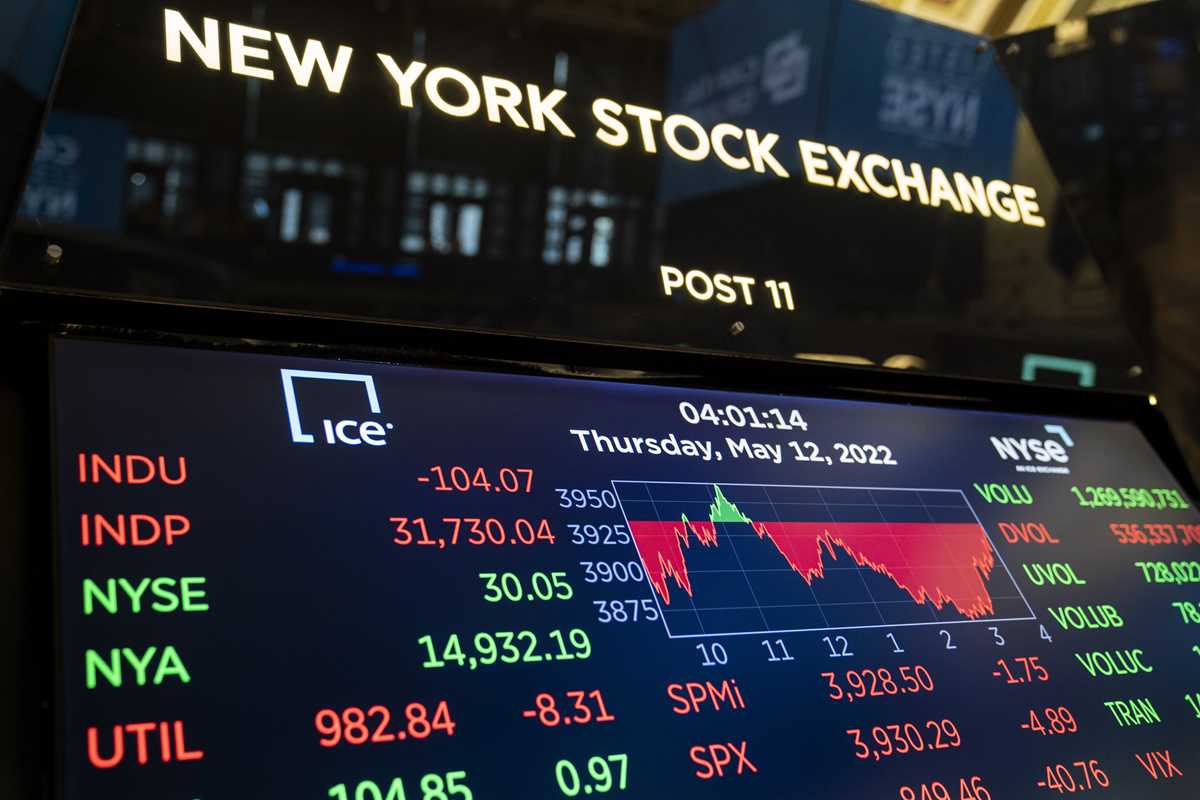 Screens display end-of-day trading results at the New York Stock Exchange on May 12, 2022, in New York. A longstanding rule of thumb holds that a recession occurs when the economy shrinks for two consecutive quarters. On Thursday, July 28 the government will report gross domestic product, the broadest measure of the nation's output of goods and services, for the April-June quarter. Some economists forecast it will show the economy shrank — for the second quarter in a row. (AP Photo/John Minchillo, File)
Screens display end-of-day trading results at the New York Stock Exchange on May 12, 2022, in New York. A longstanding rule of thumb holds that a recession occurs when the economy shrinks for two consecutive quarters. On Thursday, July 28 the government will report gross domestic product, the broadest measure of the nation's output of goods and services, for the April-June quarter. Some economists forecast it will show the economy shrank — for the second quarter in a row. (AP Photo/John Minchillo, File) A man shops at a supermarket on Wednesday, July 27, 2022, in New York. The U.S. economy shrank from April through June for a second straight quarter, contracting at a 0.9% annual pace and raising fears that the nation may be approaching a recession. (AP Photo/Andres Kudacki)
A man shops at a supermarket on Wednesday, July 27, 2022, in New York. The U.S. economy shrank from April through June for a second straight quarter, contracting at a 0.9% annual pace and raising fears that the nation may be approaching a recession. (AP Photo/Andres Kudacki)WASHINGTON (AP) — Whether the U.S. economy is heading for a recession got more difficult to answer Friday, when a report showed employers hired hundreds of thousands more workers last month than expected.
The stunning strength made clear that a linchpin of the economy remains solid. That's even though inflation is running at its worst pace in 40 years, the economy's output shrunk through the first half of the year and rising interest rates are dragging on housing and other industries. All the confounding numbers only make the long-term outlook for the economy more muddied.
On one hand, two straight quarters of economic contraction is a long-held, though informal, definition of a recession. It would mark a quick turnaround barely two years after the official end of the pandemic recession. Yet can a recession really occur when so many people still have jobs and are making more money?
It's the latest head-scratcher regarding an economy that has confounded Federal Reserve policymakers and many economists since growth screeched to a halt in March 2020 as COVID-19 struck and 20 million Americans were suddenly thrown out of work.
While most economists — and Fed Chair Jerome Powell — have said they don't think the economy is currently in a recession, with Friday's data cementing the case for many, expectations are still high for an economic downturn to begin later this year or next.
Friday's strong jobs report may actually increase the chances of a recession because it could embolden the Federal Reserve to stay aggressive in hiking interest rates in order to beat back inflation. Higher rates slow the economy by making purchases of homes, cars and things bought on credit cards more expensive, and the Fed is jacking up rates at the fastest pace since the early 1980s.
Perhaps even more important than whether a recession occurs is whether workers' paychecks catch up with inflation. So far, gains in average wages have not, and the pain is disproportionately hitting lower-income and Black and Hispanic households. As a result, Americans have increasingly soured on the economy.
That may be what moves more people in November's midterm elections than whether or not a recession has officially begun.
So how, exactly, do we know when an economy is in recession? Here are some answers to such questions:
____
WHO DECIDES WHEN A RECESSION HAS STARTED?
Recessions are officially declared by the obscure-sounding National Bureau of Economic Research, a group of economists whose Business Cycle Dating Committee defines a recession as “a significant decline in economic activity that is spread across the economy and lasts more than a few months.”
The committee considers trends in hiring as a key measure in determining recessions. It also assesses many other data points, including gauges of income, employment, inflation-adjusted spending, retail sales and factory output. It puts heavy weight on jobs and a gauge of inflation-adjusted income that excludes government support payments such as Social Security.
Yet the NBER typically doesn't declare a recession until well after one has begun, sometimes for up to a year. Economists consider a half-point rise in the unemployment rate, averaged over several months, as the most historically reliable sign of a downturn. On Friday, the latest jobs report showed the unemployment rate matched its lowest level in more than 50 years.
___
DO TWO STRAIGHT QUARTERS OF ECONOMIC CONTRACTION EQUAL A RECESSION?
That's a common rule of thumb, but it isn't an official definition.
Still, in the past, it has been a useful measure. Michael Strain, an economist at the right-leaning American Enterprise Institute, notes that in each of the past 10 times that the economy shrank for two consecutive quarters, a recession has resulted.
Still, even Strain isn't sure we're in recession now. Like many economists, he notes that the underlying drivers of the economy — consumer spending, business investment, home purchases — all grew in the first quarter.
Overall gross domestic product — the broadest measure of the nation's output — declined at a 1.6% annual rate from January through March because of one-off factors, including a sharp jump in imports and a post-holiday season drop in businesses' inventories. Many economists expect that when GDP is revised later this year, the first quarter may even turn out to be positive.
“The basic story is that the economy is growing but still slowing, and that slowdown really accelerated in the second quarter," Strain said.
___
DON’T A LOT OF PEOPLE THINK A RECESSION IS COMING?
Yes, because many people now feel more financially burdened. With wage gains trailing inflation for most people, higher prices for such essentials as gas, food, and rent have eroded Americans' spending power,
Walmart recently reported that higher gas and food costs have forced its shoppers to reduce their purchases of discretionary spending such as new clothing, a clear sign that consumer spending, a key driver of the economy, is weakening. The nation's largest retailer, Walmart reduced its profit outlook and said it will have to discount more items like furniture and electronics.
And the Fed's rate hikes have caused average mortgage rates to nearly double to 4.99%, causing a sharp fall in home sales and construction.
Higher rates will also likely weigh on businesses' willingness to invest in new buildings, machinery and other equipment. If companies reduce spending and investment, they'll also start to slow hiring. Rising caution among companies about spending freely could lead eventually to layoffs. If the economy were to lose jobs and the public were to grow more fearful, consumers would further reduce spending.
The Fed's rapid rate hikes have raised the likelihood of recession in the next two years to nearly 50%, Goldman Sachs economists have said. And Bank of America economists now forecast a “mild” recession later this year, while Deutsche Bank expects a recession early next year.
___
WHAT ARE SOME SIGNS OF AN IMPENDING RECESSION?
The clearest signal that a recession is under way, economists say, would be a steady rise in job losses and a surge in unemployment. In the past, an increase in the unemployment rate of three-tenths of a percentage point, on average over the previous three months, has meant that a recession will soon follow.
Many economists monitor the number of people who seek unemployment benefits each week, which indicates whether layoffs are worsening. Weekly applications for jobless aid, averaged over the past four weeks, have been rising recently and have topped 250,000. While that is a potentially concerning sign, it is still a low level historically.
___
ANY OTHER SIGNALS TO WATCH FOR?
Many economists also monitor changes in the interest payments, or yields, on different bonds for a recession signal known as an “inverted yield curve.” This occurs when the yield on the 10-year Treasury falls below the yield on a short-term Treasury, such as the 3-month T-bill. That is unusual. Normally, longer-term bonds pay investors a richer yield in exchange for tying up their money for a longer period.
Inverted yield curves generally mean that investors foresee a recession that will compel the Fed to slash rates. Inverted curves often predate recessions. Still, it can take 18 to 24 months for a downturn to arrive after the yield curve inverts.
For weeks, the yield on the two-year Treasury has exceeded the 10-year yield, suggesting that markets expect a recession soon. Many analysts say, though, that comparing the 3-month yield to the 10-year has a better recession-forecasting track record. Those rates are not inverted now, though the gap has narrowed.
___
WILL THE FED KEEP RAISING RATES EVEN AS THE ECONOMY SLOWS?
The economy's flashing signals — slowing growth with strong hiring — have put the Fed in a tough spot. Chair Jerome Powell is aiming for a “soft landing,” in which the economy weakens enough to slow hiring and wage growth without causing a recession and brings inflation back to the Fed's 2% target.
But Powell has acknowledged that such an outcome has grown more difficult to achieve. Russia's invasion of Ukraine and China's COVID-19 lockdowns have driven up prices for energy food, and many manufactured parts in the U.S.
Powell has also indicated that if necessary, the Fed will keep raising rates even amid a weak economy if that's what's needed to tame inflation.
“Is there a risk that we would go too far?" Powell asked last month. "Certainly there’s a risk, but I wouldn’t agree that’s the biggest risk to the economy. The biggest mistake to make…would be to fail to restore price stability.”
Before you make your next trade, you'll want to hear this.
MarketBeat keeps track of Wall Street's top-rated and best performing research analysts and the stocks they recommend to their clients on a daily basis.
Our team has identified the five stocks that top analysts are quietly whispering to their clients to buy now before the broader market catches on... and none of the big name stocks were on the list.
They believe these five stocks are the five best companies for investors to buy now...
See The Five Stocks Here
MarketBeat has just released its list of 20 stocks that Wall Street analysts hate. These companies may appear to have good fundamentals, but top analysts smell something seriously rotten. Are any of these companies lurking around your portfolio? Find out by clicking the link below.
Get This Free Report